
Opossums are members of the marsupial order Didelphimorphia endemic to the Americas. The largest order of marsupials in the Western Hemisphere, it comprises 93 species in 18 genera. Opossums originated in South America and entered North America in the Great American Interchange following the connection of North and South America.

Alston's mouse opossum, also known as Alston's opossum, is a medium-sized pouchless marsupial of the family Didelphidae. It is arboreal and nocturnal, inhabiting forests from Belize to northern Colombia. The main components of its diet are insects and fruits, but it may also eat small rodents, lizards, and bird eggs. It was formerly assigned to the genus Micoureus, which was made a subgenus of Marmosa in 2009.
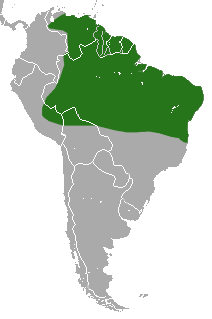
The woolly mouse opossum or long-furred woolly mouse opossum, known locally as the cuíca, is a South American marsupial of the family Didelphidae. Its range includes central Colombia, Venezuela, French Guiana, Guyana, Suriname, eastern Peru, northern Bolivia, and northern Brazil. It was formerly assigned to the genus Micoureus, which was made a subgenus of Marmosa in 2009.

The bare-tailed woolly mouse opossum or short-furred woolly mouse opossum is a South American marsupial of the family Didelphidae. Its range includes Brazil, Colombia, Ecuador, Peru, and Bolivia. It is found in tropical rainforest in the westernmost portion of the Amazon Basin and the eastern foothills of the Andes, at elevations up to 1634 m. It was formerly assigned to the genus Micoureus, which was made a subgenus of Marmosa in 2009.
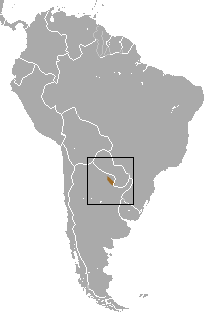
The Chacoan pygmy opossum is a recently described genus and species of didelphimorph marsupial. The only species in Chacodelphys, C. formosa, was known until 2004 from only one specimen collected in 1920 in the Chaco of Formosa Province, Argentina. The species is gaining popularity as a pocket pet.
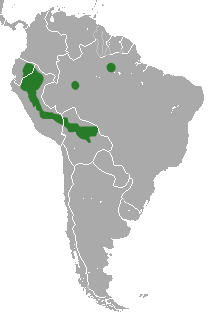
The bushy-tailed opossum is an opossum from South America. It was first described by English zoologist Oldfield Thomas in 1912. It is a medium-sized opossum characterized by a large, oval, dark ears, fawn to cinnamon coat with a buff to gray underside, grayish limbs, and a furry tail. Little is known of the behavior of the bushy-tailed opossum; less than 25 specimens are known. It appears to be arboreal (tree-living), nocturnal and solitary. The diet probably comprises insects, eggs and plant material. This opossum has been captured from heavy, humid, tropical forests; it has been reported from Bolivia, Brazil, Colombia, Ecuador and Peru. The IUCN classifies it as least concern.
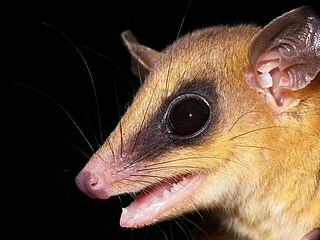
The 27 species in the genus Marmosa are relatively small Neotropical members of the family Didelphidae. This genus is one of three that are known as mouse opossums. The others are Thylamys and Tlacuatzin, the grayish mouse opossum. Members of the genus Marmosops used to be called "slender mouse opossums", but are now just called "slender opossums". The thirteen members of the Marmosa subgenus Micoureus, known as woolly mouse opossums, were formerly considered to be a separate genus, but were moved into Marmosa in 2009. Based on a comparison of sequences of one mitochondrial and three nuclear genes, three new subgenera, Eomarmosa, Exulomarmosa and Stegomarmosa, were recognized by Voss et al. in 2014. Eomarmosa and Exulomarmosa, as well as Marmosa and Micoureus, are thought to be sister taxa, while Stegomarmosa is viewed as sister to Marmosa plus Micoureus. Exulomarmosa is a mostly trans-Andean clade.
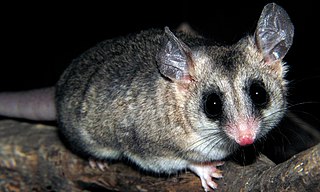
Thylamys is a genus of opossums in the family Didelphidae. The premaxillae are rounded rather than pointed. The females lack a pouch. The females' nipples are arranged in two symmetrical rows on the abdomen. All species but T. macrurus store fat in their tails., although this is not necessarily true for all species in the genus. Fossils belonging to the genus date back to the Miocene, with the oldest specimens being found in the Cerro Azul Formation of Argentina and the Honda Group of Colombia. Genetic studies indicate that the genus may have originated around 14 million years ago.

The white-bellied fat-tailed mouse opossum is a species of opossum in the family Didelphidae. It is found in Argentina, Bolivia, Chile and Peru.
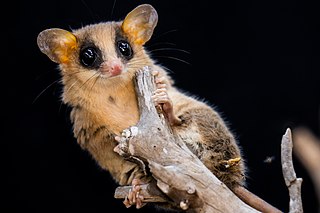
Gracilinanus is a genus of opossum in the family Didelphidae. It was separated from the genus Marmosa in 1989, and has since had the genera Cryptonanus, Chacodelphys, and Hyladelphys removed from it.

The Didelphinae are a subfamily of opossums consisting of 15 genera and 123 species. Specimens have been collected throughout the Americas, but are predominant in South and Central America.
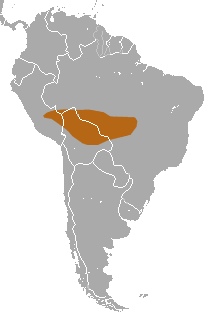
Bishop's slender opossum is a small, arboreal marsupial opossum native to Brazil, Peru, and Bolivia. It somewhat resembles a placental rat or shrew.
The red-bellied gracile opossum is an extinct species of opossum that was native to Jujuy Province in northwest Argentina. Its forest habitat has been destroyed, and it was last seen in 1962.
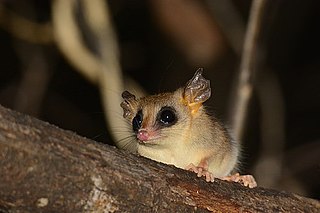
Agricola's gracile opossum is a species of opossum in the family Didelphidae endemic to eastern Brazil. Its habitat is the caatinga and cerrado. While its conservation status has not been determined, expansion of agricultural activities is leading to loss of some of its habitat. There are several protected areas in the species' range but it has not been collected from these areas. The species is named after Brazilian physician Ernani Agricola.
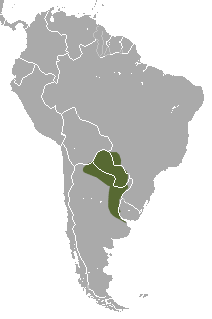
The chacoan gracile opossum is a species of opossum in the family Didelphidae. It is native to Argentina, Brazil and Paraguay. Its habitat is seasonally flooded grasslands and forests in and near the Gran Chaco.

The Guahiba gracile opossum is a species of opossum in the family Didelphidae. It is endemic to southern Brazil, where it is known only from three islands, Guahiba, São Lourenço, and Taquara, in the state of Rio Grande do Sul. The poorly studied species is presumed to inhabit subtropical forests, and thus to be threatened by deforestation.

The Unduavi gracile opossum is a species of opossum in the family Didelphidae. It is native to northern Bolivia, where it has been found in seasonally flooded grassland. Some of the specimens recognized by Voss et al. as belonging to this species were previously classified as the unduaviensis or buenavistae subspecies of Gracilinanus agilis.

Tate's woolly mouse opossum is an omnivorous, arboreal South American marsupial of the family Didelphidae, named after American zoologist George Henry Hamilton Tate. It is native to Atlantic coastal forests of Brazil, Paraguay and Argentina. The species lives in both primary and secondary forest, including forest fragments within grassland. Insects are a major component of its diet. It was formerly assigned to the genus Micoureus, which was made a subgenus of Marmosa in 2009. While its conservation status is "least concern", its habitat is shrinking through urbanization and conversion to agriculture over much of its range.



















